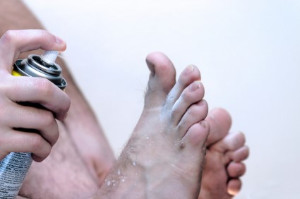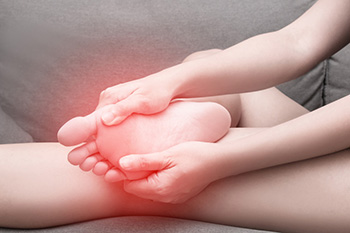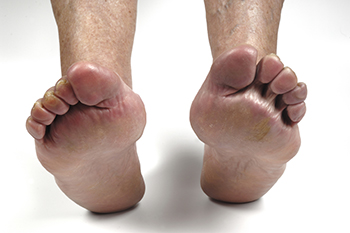Dallas (214) 340-8885
Athens (903) 677-9090
Gun Barrel City (903) 887-4341
Dallas (214) 340-8885
Athens (903) 677-9090
Gun Barrel City (903) 887-4341

Athlete's foot, a common fungal infection, thrives in warm, moist environments like locker rooms and swimming pools. Symptoms include itching, burning, and cracked, peeling skin between toes. To prevent it, keep your feet clean and dry, wear breathable footwear, and avoid walking barefoot in public areas. Treatment options range from over-the-counter antifungal creams and powders to prescription medications for persistent infections. Maintaining good foot hygiene, such as washing feet daily and drying them thoroughly, is important. If symptoms persist or worsen despite self-care measures, a podiatrist can confirm the diagnosis, recommend appropriate medications, and provide tips to prevent recurrence. Prompt treatment not only alleviates discomfort but also prevents the spread of the infection to other parts of the body or to others. If you suffer from athlete’s foot, it is suggested you make an appointment with a podiatrist for a treatment plan.
Athlete’s Foot
Athlete’s foot is often an uncomfortable condition to experience. Thankfully, podiatrists specialize in treating athlete’s foot and offer the best treatment options. If you have any questions about athlete’s foot, consult with Dr. Jonathan Kletz from Texas Foot Works. Our doctor will assess your condition and provide you with quality treatment.
What Is Athlete’s Foot?
Tinea pedis, more commonly known as athlete’s foot, is a non-serious and common fungal infection of the foot. Athlete’s foot is contagious and can be contracted by touching someone who has it or infected surfaces. The most common places contaminated by it are public showers, locker rooms, and swimming pools. Once contracted, it grows on feet that are left inside moist, dark, and warm shoes and socks.
Prevention
The most effective ways to prevent athlete’s foot include:
Symptoms
Athlete’s foot initially occurs as a rash between the toes. However, if left undiagnosed, it can spread to the sides and bottom of the feet, toenails, and if touched by hand, the hands themselves. Symptoms include:
Diagnosis and Treatment
Diagnosis is quick and easy. Skin samples will be taken and either viewed under a microscope or sent to a lab for testing. Sometimes, a podiatrist can diagnose it based on simply looking at it. Once confirmed, treatment options include oral and topical antifungal medications.
If you have any questions, please feel free to contact one of our our offices located in Dallas, Athens, and Gun Barrel City, TX . We offer the newest diagnostic and treatment technologies for all your foot care needs.
 Metatarsalgia, a painful inflammation in the ball of the foot, commonly stems from overuse injuries in sports that involve running and jumping. Wearing poorly fitting shoes, foot abnormalities like high arches or bunions, and conditions such as arthritis can also contribute to this condition. Pain in the ball of the foot typically develops gradually and may worsen with activities like standing, walking, or high-impact sports. Symptoms can include a sensation of walking on a pebble, sharp burning pain, and numbness or tingling in the toes. Treatment by a podiatrist focuses on addressing the underlying cause and relieving pain. Conservative measures include resting the foot and taking pain relievers. Changing to well-fitting shoes with good support and using orthotic pads can also help to alleviate discomfort. Weight loss, if applicable, can reduce pressure on the metatarsal area. In more persistent cases, custom orthotics may be recommended to improve gait and foot mechanics. Surgery is considered to be a last resort if conservative treatments fail. If you are experiencing pain in the ball of the foot, it is suggested that you schedule an appointment with a podiatrist for an exam, diagnosis, and treatment options.
Metatarsalgia, a painful inflammation in the ball of the foot, commonly stems from overuse injuries in sports that involve running and jumping. Wearing poorly fitting shoes, foot abnormalities like high arches or bunions, and conditions such as arthritis can also contribute to this condition. Pain in the ball of the foot typically develops gradually and may worsen with activities like standing, walking, or high-impact sports. Symptoms can include a sensation of walking on a pebble, sharp burning pain, and numbness or tingling in the toes. Treatment by a podiatrist focuses on addressing the underlying cause and relieving pain. Conservative measures include resting the foot and taking pain relievers. Changing to well-fitting shoes with good support and using orthotic pads can also help to alleviate discomfort. Weight loss, if applicable, can reduce pressure on the metatarsal area. In more persistent cases, custom orthotics may be recommended to improve gait and foot mechanics. Surgery is considered to be a last resort if conservative treatments fail. If you are experiencing pain in the ball of the foot, it is suggested that you schedule an appointment with a podiatrist for an exam, diagnosis, and treatment options.
Foot Pain
Foot pain can be extremely painful and debilitating. If you have a foot pain, consult with Dr. Jonathan Kletz from Texas Foot Works. Our doctor will assess your condition and provide you with quality foot and ankle treatment.
Causes
Foot pain is a very broad condition that could be caused by one or more ailments. The most common include:
Diagnosis
To figure out the cause of foot pain, podiatrists utilize several different methods. This can range from simple visual inspections and sensation tests to X-rays and MRI scans. Prior medical history, family medical history, and any recent physical traumatic events will all be taken into consideration for a proper diagnosis.
Treatment
Treatment depends upon the cause of the foot pain. Whether it is resting, staying off the foot, or having surgery; podiatrists have a number of treatment options available for foot pain.
If you have any questions, please feel free to contact one of our our offices located in Dallas, Athens, and Gun Barrel City, TX . We offer the newest diagnostic and treatment technologies for all your foot care needs.

Diabetic foot ulcers are serious complications of diabetes, characterized by open sores or wounds that typically develop on the feet. They result from poor circulation, nerve damage, also called neuropathy, and impaired immune function associated with diabetes. Treatment involves meticulous wound care, which includes cleaning the ulcer with gentle soap and water, applying antibiotic ointment, and covering it with a sterile dressing. Offloading pressure from the affected foot is important to prevent further irritation and aid healing. Podiatrists can conduct regular exams to monitor ulcers, assess circulation, and provide guidance on footwear and hygiene. Timely intervention can prevent complications such as infections or amputations. If you have diabetes, it is strongly suggested you visit a podiatrist who can help you to manage this condition.
Wound care is an important part in dealing with diabetes. If you have diabetes and a foot wound or would like more information about wound care for diabetics, consult with Dr. Jonathan Kletz from Texas Foot Works. Our doctor will assess your condition and provide you with quality foot and ankle treatment.
What Is Wound Care?
Wound care is the practice of taking proper care of a wound. This can range from the smallest to the largest of wounds. While everyone can benefit from proper wound care, it is much more important for diabetics. Diabetics often suffer from poor blood circulation which causes wounds to heal much slower than they would in a non-diabetic.
What Is the Importance of Wound Care?
While it may not seem apparent with small ulcers on the foot, for diabetics, any size ulcer can become infected. Diabetics often also suffer from neuropathy, or nerve loss. This means they might not even feel when they have an ulcer on their foot. If the wound becomes severely infected, amputation may be necessary. Therefore, it is of the upmost importance to properly care for any and all foot wounds.
How to Care for Wounds
The best way to care for foot wounds is to prevent them. For diabetics, this means daily inspections of the feet for any signs of abnormalities or ulcers. It is also recommended to see a podiatrist several times a year for a foot inspection. If you do have an ulcer, run the wound under water to clear dirt from the wound; then apply antibiotic ointment to the wound and cover with a bandage. Bandages should be changed daily and keeping pressure off the wound is smart. It is advised to see a podiatrist, who can keep an eye on it.
If you have any questions, please feel free to contact one of our our offices located in Dallas, Athens, and Gun Barrel City, TX . We offer the newest diagnostic and treatment technologies for all your foot care needs.
 Cracked heels, medically known as keratoderma, is a condition where the skin on the heels becomes thick, dry, and eventually splits. This often painful issue arises from prolonged pressure on the feet, leading to hard, callused skin that can fissure. Causes include standing for long periods, wearing open-backed shoes, and exposure to dry, cold weather. Medical conditions like diabetes and hypothyroidism also contribute by causing excessively dry skin. Excessive weight increases pressure on the heel pads, further worsening the problem. Preventing keratoderma involves regular moisturizing, wearing supportive, closed-back footwear, and avoiding prolonged standing on hard surfaces. Proper foot care routines, including gentle exfoliation and hydration, are essential to maintain soft, healthy skin and prevent the discomfort associated with cracked heels. This condition can be painful. If this applies to you, it is suggested that you visit a podiatrist who can effectively treat cracked heels, which often includes prescribed medication.
Cracked heels, medically known as keratoderma, is a condition where the skin on the heels becomes thick, dry, and eventually splits. This often painful issue arises from prolonged pressure on the feet, leading to hard, callused skin that can fissure. Causes include standing for long periods, wearing open-backed shoes, and exposure to dry, cold weather. Medical conditions like diabetes and hypothyroidism also contribute by causing excessively dry skin. Excessive weight increases pressure on the heel pads, further worsening the problem. Preventing keratoderma involves regular moisturizing, wearing supportive, closed-back footwear, and avoiding prolonged standing on hard surfaces. Proper foot care routines, including gentle exfoliation and hydration, are essential to maintain soft, healthy skin and prevent the discomfort associated with cracked heels. This condition can be painful. If this applies to you, it is suggested that you visit a podiatrist who can effectively treat cracked heels, which often includes prescribed medication.
Cracked heels are unsightly and can cause further damage to your shoes and feet. If you have any concerns, contact Dr. Jonathan Kletz from Texas Foot Works. Our doctor can provide the care you need to keep you pain-free and on your feet.
Cracked Heels
Cracked heels appear unappealing and can make it harder for you walk around in sandals. Aside from looking unpleasant, cracked heels can also tear stockings, socks, and wear out your shoes. There are several methods to help restore a cracked heel and prevent further damage.
How Do You Get Them?
Dry skin is the number one culprit in creating cracked heels. Many athletes, walkers, joggers, and even swimmers suffer from cracked heels. Age and skin oil production play a role to getting cracked heels as well.
Promote Healing
Over the counter medicines can help, especially for those that need instant relief or who suffer from chronic dry feet.
Wear Socks – Wearing socks with medicated creams helps lock in moisture.
Moisturizers – Applying both day and night will help alleviate dryness which causes cracking.
Pumice Stones – These exfoliate and remove dead skin, which allows for smoother moisturizer application and better absorption into the skin.
Change in Diet
Eating healthy with a well-balanced diet will give the skin a fresh and radiant look. Your body responds to the kinds of food you ingest. Omega-3 fatty acids and zinc supplements can also revitalize skin tissue.
Most importantly, seek professional help if unsure how to proceed in treating cracked heels. A podiatrist will help you with any questions or information needed.
If you have any questions, please feel free to contact one of our our offices located in Dallas, Athens, and Gun Barrel City, TX . We offer the newest diagnostic and treatment technologies for all your foot care needs.
 Rheumatoid arthritis, or RA, is an autoimmune disorder where the immune system mistakenly attacks the joints, causing inflammation, pain, and swelling. This condition can significantly affect the feet, leading to discomfort and mobility issues. RA occurs due to a combination of genetic and environmental factors, and it is more common in women and those with a family history of the disease. Symptoms in the feet include persistent pain, swelling, stiffness, and deformities such as bunions and hammertoes. Early diagnosis is important and typically involves physical examinations, imaging tests, and blood tests to identify specific markers. Management of RA in the feet includes medications like anti-inflammatory drugs and disease-modifying antirheumatic drugs to control symptoms and prevent joint damage. Preventive measures involve maintaining a healthy weight, regular exercise, and wearing supportive footwear. In severe cases, surgical interventions may be necessary. If you have symptoms of rheumatoid arthritis in your feet, it is suggested that you schedule regular visits with a podiatrist to monitor and manage your foot health.
Rheumatoid arthritis, or RA, is an autoimmune disorder where the immune system mistakenly attacks the joints, causing inflammation, pain, and swelling. This condition can significantly affect the feet, leading to discomfort and mobility issues. RA occurs due to a combination of genetic and environmental factors, and it is more common in women and those with a family history of the disease. Symptoms in the feet include persistent pain, swelling, stiffness, and deformities such as bunions and hammertoes. Early diagnosis is important and typically involves physical examinations, imaging tests, and blood tests to identify specific markers. Management of RA in the feet includes medications like anti-inflammatory drugs and disease-modifying antirheumatic drugs to control symptoms and prevent joint damage. Preventive measures involve maintaining a healthy weight, regular exercise, and wearing supportive footwear. In severe cases, surgical interventions may be necessary. If you have symptoms of rheumatoid arthritis in your feet, it is suggested that you schedule regular visits with a podiatrist to monitor and manage your foot health.
Arthritis can be a difficult condition to live with. If you are seeking treatment, contact Dr. Jonathan Kletz from Texas Foot Works. Our doctor can provide the care you need to keep you pain-free and on your feet.
Arthritic Foot Care
Arthritis is a term that is commonly used to describe joint pain. The condition itself can occur to anyone of any age, race, or gender, and there are over 100 types of it. Nevertheless, arthritis is more commonly found in women compared to men, and it is also more prevalent in those who are overweight. The causes of arthritis vary depending on which type of arthritis you have. Osteoarthritis for example, is often caused by injury, while rheumatoid arthritis is caused by a misdirected immune system.
Symptoms
Arthritic symptoms range in severity, and they may come and go. Some symptoms stay the same for several years but could potentially get worse with time. Severe cases of arthritis can prevent its sufferers from performing daily activities and make walking difficult.
Risk Factors
If you suspect your arthritis is affecting your feet, it is crucial that you see a podiatrist immediately. Your doctor will be able to address your specific case and help you decide which treatment method is best for you.
If you have any questions, please feel free to contact one of our our offices located in Dallas, Athens, and Gun Barrel City, TX . We offer the newest diagnostic and treatment technologies for all your foot care needs.